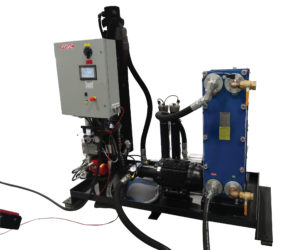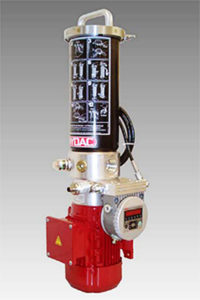
Hydraulic systems are generally equipped with system filters. The system filters are either placed on the pressure side (e.g. downstream of pumps, before system components) or on the return side (e.g. before fluid is reaching the reservoir).
Dan Zoller, Group Product Manager Filter Systems, Schroeder Industries, said that in a case where only one filter is used, this one filter has to remove all the dirt generated in the system. “By using two filters in the system (e.g. pressure and return filters), the work load is shared and it is easier to maintain a fluid cleanliness level recommended for the hydraulic system. However, the reservoir might still contain contamination accumulated over time and from the environment. In order to improve the reservoir cleanliness and to help in extending the life expectancy of the elements in the system filters, an off-line kidney loop system can often be added.”
How do kidney loop filtration systems differ from other filtration systems?
Zoller explained that a kidney loop system contains a motor, a pump and a filter to form an independent unit. This kidney loop system is placed on a reservoir and can run intermediately as needed or it can run continuously.
“Because the kidney loop system is not exposed to the hydraulic system itself and all the possible pressure variations, it is very efficient in removing dirt from the fluid and holding it in the filter elements without releasing it back into the fluid.”

He adds that it is important to note that depending on the hydraulic system, the fluid might not be used (flowing) all the time and, therefore, only needs to be filtered at certain times. “Therefore, one key benefit of this technology is that an independent kidney loop system can run 24/7 and polish the fluid even when the hydraulic system is down or switched off. “
Types of kidney loop systems
There are a variety of self-contained kidney loop filtration systems equipped with high efficiency elements to remove solid particulates and/or water quickly and efficiently.
“Kidney loop systems with dual filters, so called Staged Filtration, are preferred.” Zoller said. “It allows removal of larger particles in the first filter and smaller particles in the second filter. E.g. a 10 Micron element in the first filter and a 5 Micron element in the second filter prevents the first filter from filling up prematurely and allow element change intervals to be aligned more closely on both filters. In addition, the first filter can be equipped with a water absorbing element to remove free water, if the fluid has high water content.”

Matching the kidney loop system to the application
Flow rates for kidney loop systems can vary widely and customized solutions are usually sized based on the reservoir size, or fluid amount to be handled. By selecting specific filters, so called ‘High Dirt Holding Capacity Filters,’ or a larger number of filters for staged filtration, the dirt holding capacity can be extended, and other functions can be incorporated (e.g. heater, cooler, Contamination Sensor, etc.).
In conclusion, Zoller said that the range of these off-line systems that can be used to supplement inline filters when adequate fluid cleanliness is not being achieved provides solutions for virtually all external filtration needs.
“Various model options include wheels, particle monitors, and sophisticated PLCs. The key is always matching your specific application to the right kidney loop system.”
By Joyce Laird

very helpful information, much appreciated, I am a service technician at atlas copco